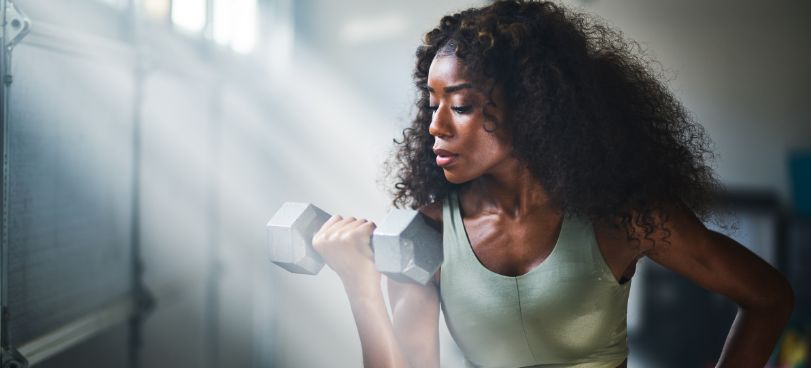What You Need to Know About How to Build Muscle
Did you know that, on average, a sedentary person loses about ¼ pound of muscle per one pound of body weight lost?
Most people don’t think about where they’re losing weight as long as the number on the scale is going down, but it’s important to focus on how to lose fat and gain muscle during your weight loss journey.
Maintaining muscle mass is critical to support metabolism, reduce injury and protect the most important muscle in your body – your heart! Rapid weight loss (more than about 2 pounds per week) puts you at an even greater risk of muscle loss.
In that spirit, here’s a quick explanation of the importance of muscle mass and a few tips for how to lose fat and gain muscle!
Why Should I Build Muscle To Lose Weight?
Many people mistakenly believe that building muscle is just for those who want to look like bodybuilders.
As a result, women sometimes dismiss lifting weights as an exercise that’s only for men, but that couldn’t be farther from the truth!
Without a specific (and concentrated) intention to do so, weight training won’t leave you bursting out of your shirt like the Incredible Hulk.
Instead, regular weight training will tone your body – including your stomach and upper arms – and leave you feeling stronger for your day-to-day activities.
More lean muscle mass also increases calorie burn at rest, which helps you burn more calories even when you’re not working out.
Muscle Burns More Calories
The best way to understand how muscle works is by thinking of the muscle in your body as a bonfire: raging and eager to burn up any fuel you give it.
By comparison, the fat in your body is like the tiny flame at the tip of a lit match. While both flames will eventually burn up the fuel, the match will take much longer than the larger, more active bonfire.
So, what does all of this mean for weight loss?
Muscle is significantly more metabolically active than fat. It burns through fuel faster, so the more muscle you have, the more calories (and fat) you burn each day.
Whether you’re doing a class at the gym, shopping, walking along the beach, or sleeping, your muscles remain active. They’re constantly feeding on calories and burning through your extra fuel!
In fact, every pound of muscle burns between 50 and 150 calories per day just to sustain itself. In contrast, each pound of fat burns only 1 to 3 calories daily. If you think about how much that difference adds up daily, it’s a huge difference in your overall metabolic rate and calorie burn!
THIS is why it’s essential to lose fat and build muscle during your weight loss journey.
Muscle Takes Up Less Space
In addition, one pound of muscle takes up about 20% less space than one pound of fat.
This difference in density explains why you sometimes look thinner, even when the scale isn’t budging – especially if you’ve been working out a lot. If you lose 5 pounds of fat and gain 5 pounds of muscle, you look slimmer, even if the scale doesn’t change.
Lots of doctors and patients measure progress with a scale but don’t disregard the importance of losing inches.
Losing fat around your waist is great for your self-esteem (hello, smaller pant size!), and recent research shows it’s beneficial for your health too.
Essentially, building muscle will help you to achieve a lean and toned appearance, and boost your metabolism, so that you can reach and maintain your goal weight (and figure) for longer.
Why Building Muscle Means More Weight Loss
Building muscle is important for anyone on a weight loss journey.
A higher percentage of lean muscle mass helps boost metabolism and prevent injury, both of which help you keep up with your new fitness routine and keep the weight off long-term!
Unfortunately, many people focus on the short-term objective of losing weight. As a result, it’s common to hear about crash dieting and intense cardio activities (like running or cycling) to achieve the immediate weight loss goal.
It’s preferable, however, if you see your weight loss journey as the start of a permanent lifestyle change. In parallel with healthy, long-term eating habits, aim to develop fitness habits that focus on building a better body for years to come.
One way to promote sustainable fitness and health is to concentrate on how to lose fat and gain muscle.
This transition in body composition will allow you to burn calories more efficiently without having to do hours on the treadmill or elliptical – unless you want to!
Having more muscle mass doesn’t allow you free reign to eat what you like, but it does mean that your body is better able to burn off any extra calories that you might eat.
How To Build Muscle and Lose Fat

The key to building and maintaining lean muscle mass is a combination of:
- Healthy diet
- Regular strength training
- Consistent cardio
Healthy Diet
Eating the right foods helps you build and maintain muscle. Protein, as well as particular vitamins and minerals, prove essential.
Protein
When you work out, you create mini tears in your muscle fibers, which then repair and rebuild into stronger, bigger muscles over the next few days.
However, if you don’t have enough protein your body doesn’t have the raw materials (amino acids) it needs to make new muscles. Without the ability to rebuild, existing muscle tissue deteriorates.
Rapid weight loss (more than about 2 lbs/week) can also put an extra strain on muscles if the body starts drawing on the muscles’ energy stores for fuel.
Similar to damage caused by exercise, the body needs fuel to rebuild this tissue. For this reason, it’s critical to make sure you’re eating enough calories and protein throughout the entirety of your journey.
In general, aim for 0.8-1.0 grams of protein per kilogram of body weight each day. In terms of calories, try not to drop below 1200 calories per day if you’re a woman or 1500 calories per day if you’re a man.
Other Vitamins & Minerals
As well as pumping iron, you should ensure you eat it too. Without enough iron, your body can’t get oxygen to your cells, which in turn slows down your metabolism. Good sources of iron include lean red meat, chicken, fortified cereal, and soy nuts.
Other vitamins and minerals also help convert the food you eat into lean muscle after all that weight-bearing exercise. Vitamin C, for example, is important as it speeds up muscle recovery, and magnesium helps to keep your muscles in peak condition.
Regular Strength Training
Maintaining your muscle mass doesn’t have to take long! Research shows that just 10 minutes three times per week is enough to get you on the right track to a better body and faster weight loss!
Some of the moves require light dumbbells to really benefit your body and build muscle, but if you’re working out at home, food cans or water bottles work as well!
Consistent Cardio
Just as you lose more weight with a combination of diet and exercise than with either one alone, a combination of cardio and weight-bearing exercise offers the best chance of weight loss, fat burning, and an overall healthier body.
Cardio is a crucial component because it helps you burn calories right away. Increasing your heart rate puts more demand on your heart and muscles, which burns more calories in the short term.
Plus, with cardio exercise, it’s also easy to increase your calorie burn with small changes: going faster, jumping higher, and going further all help you burn more calories as it forces your body to work hard doing things it’s not used to doing.
Cardio is also more fun for most people. Activities like running, walking, dancing, swimming, and bicycling are popular cardio forms. For most people, it’s something that you can do each and every day to increase your calorie burn and overall health.
The Best Workout to Burn Fat and Build Muscle
There is no one BEST workout to burn fat and build muscle.
Instead, aim for a regular combination of cardio (aerobic) exercise and strength training. While strength work helps you build muscle, cardio revs calorie burn and helps you burn through your body’s fat stores faster.
Most experts recommend doing some sort of cardio most days of the week and strength training around 3x per week.
Still, remember: when it comes to exercise, you should always start small and gradually work your way up to your goals. It’s also important to keep workouts interesting so that you’ll want to continue doing them.
So, now you know how to build muscle to lose weight, you can incorporate some weight training into your exercise regime and turn your body into a lean, mean calorie-burning machine!






